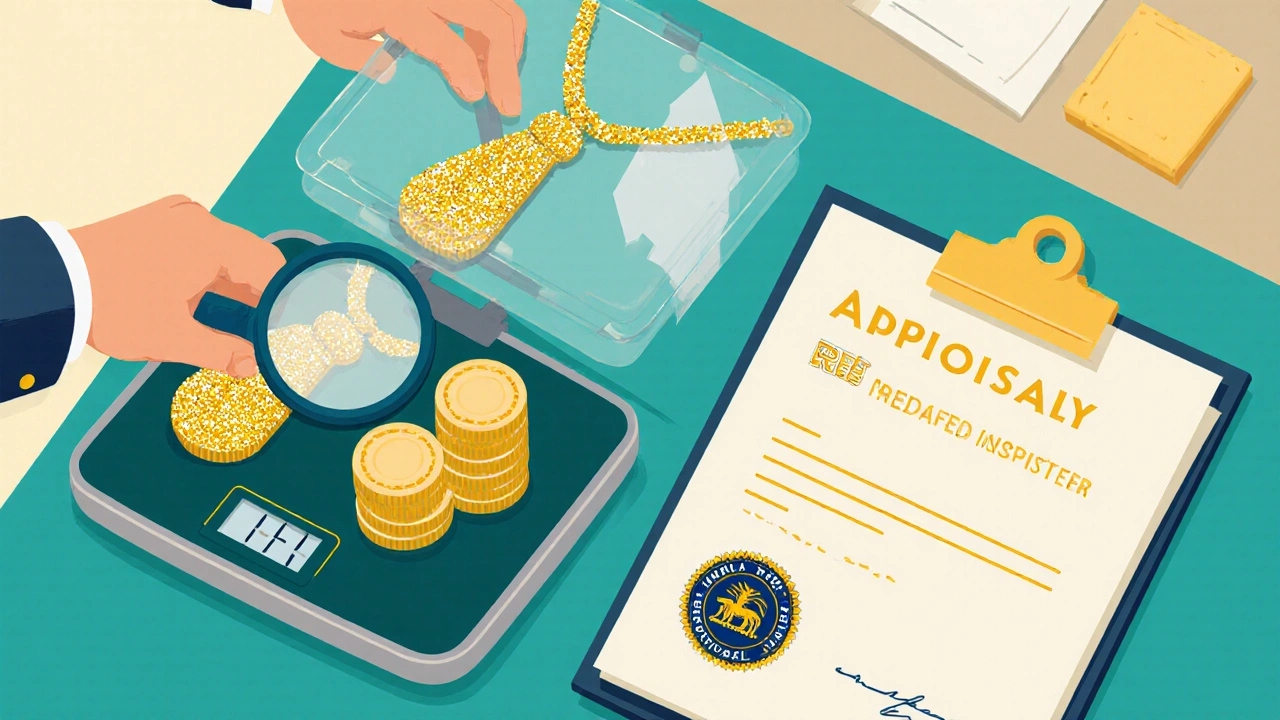Gold Loan Calculator
Your Loan Details
Maximum Loan Amount: ₹0
Total Interest (Estimated): ₹0
Monthly Payment (Approx.): ₹0
India’s gold‑loan market just got a makeover. The Reserve Bank of India (RBI) rolled out a fresh set of guidelines in March 2025, aiming to tighten risk, protect borrowers, and bring more transparency. If you’re thinking of pledging your jewellery for a loan, you’ll want to know how the new rules change the game.
What the RBI Changed
Gold loan is a short‑term secured loan where gold jewellery or bullion is used as collateral. It has long been a favorite for quick cash, but the RBI’s latest circular reshapes several key parameters.
The main updates can be grouped into five buckets: loan‑to‑value limits, interest‑rate caps, appraisal standards, documentation & processing, and borrower protection.
1. Loan‑to‑Value (LTV) Ratio Cut to 75%
Earlier, most banks could lend up to 80% of the market value of gold. Under the new LTV ratio, the ceiling is now 75% for standard gold loans and 70% for high‑risk borrowers. The RBI says this reduces exposure to price volatility and aligns Indian practice with global standards.
For example, if you pledge gold worth ₹2lakhs, the maximum loan you can receive drops from ₹1.6lakhs to ₹1.5lakhs.
2. Interest‑Rate Caps Introduced
The RBI capped the annualized interest rate for gold loans at 15% for loans up to six months and 18% for longer tenures. Previously, rates varied widely, often exceeding 20% for certain private‑non‑bank lenders.
This ceiling applies to all banks and NBFCs, ensuring borrowers don’t face hidden rate hikes. The interest rate is now disclosed upfront as an effective rate, not just the headline.
3. Mandatory Third‑Party Appraisal
All gold pledged must now be appraised by an RBI‑approved third‑party dealer (DP). The bank can no longer rely solely on its in‑house valuation. The DP issues a certificate that includes the purity, weight, and market price as of the appraisal date.
This move tackles over‑valuation scandals that surfaced in 2023, where some lenders inflated collateral values to push higher LTVs.

4. Streamlined Documentation & Digital Claims
New rules require a standard set of documents: a government‑issued ID, PAN, address proof, and a signed pledge agreement. For salaried borrowers, the latest salary slip or Form 16 is enough; self‑employed applicants must attach the latest ITR.
Importantly, banks must enable a digital claim process. Borrowers can now upload their documents via the bank’s mobile app, and the loan gets disbursed within 24hours of successful appraisal.
5. Enhanced Borrower Protection
To curb hidden fees, the RBI mandates a clear fee schedule that lists processing charges, valuation fees, and early repayment penalties. Any penalty for pre‑payment cannot exceed 2% of the outstanding principal.
Additionally, lenders must send a monthly statement via SMS/email, detailing outstanding balance, accrued interest, and next due date.
Old vs. New: Quick Comparison
| Aspect | Previous Rule | New Rule (2025) |
|---|---|---|
| LTV Ratio | Up to 80% | Maximum 75% (70% for high‑risk) |
| Interest‑Rate Cap | No cap - up to 22%+ | 15% (≤6months) / 18% (>6months) |
| Appraisal | Bank’s internal valuation | RBI‑approved third‑party DP certificate |
| Processing Time | 2‑5days (paper) | Within 24hours (digital) |
| Fee Transparency | Variable, often undisclosed | Itemised schedule, pre‑disclosed |
Eligibility Checklist for Borrowers
- Age between 21 and 60 years.
- Indian citizen or NRI with a valid PAN.
- Gold purity of 22karat or higher (for jewellery) or 24karat bullion.
- Clear title of ownership - no pending court cases.
- Minimum appraisal value of ₹50,000.

Impact on Borrowers and Lenders
For borrowers, the lower LTV means you’ll need to pledge slightly more gold for the same loan amount, but the interest‑rate caps deliver predictable costs. The mandatory third‑party appraisal adds a layer of trust - you’ll see an independent valuation instead of a bank’s estimate.
Lenders benefit from reduced credit risk. The tighter LTV and caps keep non‑performing assets low, which should translate into lower provisioning requirements and potentially better loan terms for qualified customers.
Common Pitfalls to Avoid
- Skipping the appraisal certificate. Without the DP certificate, the loan can be rejected or the LTV reduced.
- Assuming the interest rate is fixed for the loan tenure. Rates are now tied to the benchmark repo rate and may adjust after six months.
- Ignoring the pre‑payment penalty clause. Even though the cap is 2%, it still adds cost if you repay early.
- Providing incomplete documentation. Missing salary slip or ITR can delay disbursement.
How to Apply Under the New Rules
- Gather required documents: ID, PAN, address proof, salary slip/ITR, and any existing loan statements.
- Visit the bank’s mobile app or website and select the “Gold Loan” product.
- Enter the market value of your gold (use the latest rates from RBI‑approved sources).
- Upload the DP appraisal certificate once you receive it (typically within a few hours of appraisal).
- Review the itemised fee schedule and accept the terms.
- Submit the application. You’ll receive an SMS with the disbursement amount and timeline.
Future Outlook
Analysts expect the RBI to revisit the LTV ceiling annually, aligning it with global gold price trends. Some experts also predict a move toward a unified digital ledger for gold collateral, which would further streamline verification.
Frequently Asked Questions
What is the current maximum LTV for gold loans?
The RBI now caps the loan‑to‑value at 75% for regular borrowers and 70% for those classified as high‑risk.
Are interest‑rate caps applicable to all lenders?
Yes. Both scheduled banks and non‑bank financial companies (NBFCs) must adhere to the 15% (≤6months) and 18% (>6months) caps.
Do I need a third‑party appraisal for every gold loan?
Yes. The appraisal must be performed by an RBI‑approved dealer, and the certificate is mandatory for loan approval.
Can I repay my gold loan early without penalty?
Early repayment is allowed, but the penalty cannot exceed 2% of the outstanding principal as per the new guidelines.
What documents are essential for a salaried borrower?
A government‑issued ID, PAN, address proof, latest salary slip (or Form 16), and the DP appraisal certificate.
